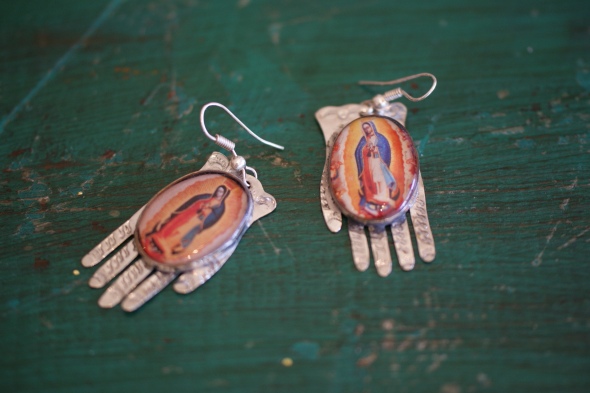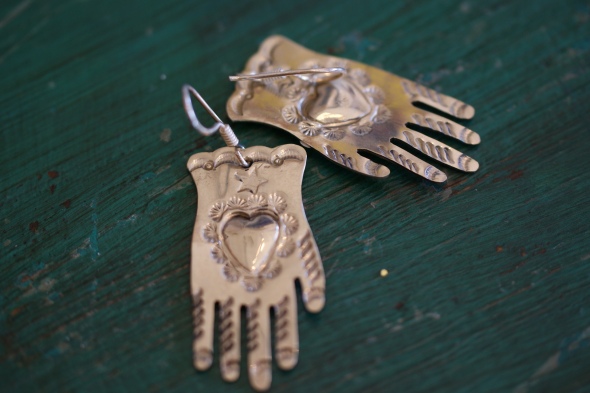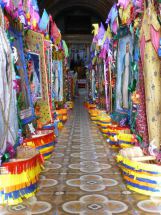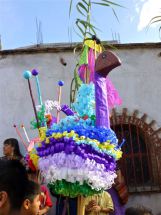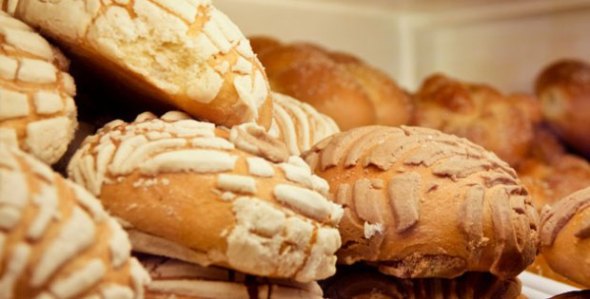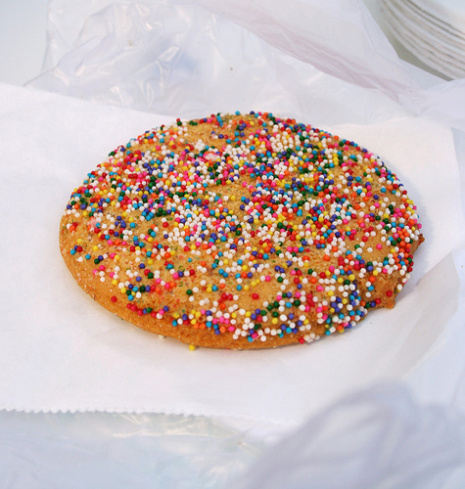Let the festivities begin! | View From Casita Colibrí
Posted: July 11, 2013 Filed under: Folk Art, Mexican Crafts, Mexican Folk Art, Mexican Holidays, Mexico, Oaxaca, Paper Folk Art, Virgin of Guadalupe | Tags: handmade, Mexican crafts, Mexican folk art, Mexican holidays, Oaxaca, paper folk art, Virgin of Guadalupe 2 CommentsSunday in Tlacolula
Let the festivities begin!
July 11, 2013 by spixl
Monday, we returned to Teotitlán del Valle for the Fiesta titular a la Preciosa Sangre de Nuestro Señor Jesucristo — the pueblo’s most important festival of the year. While special masses have been celebrated at the Templo de la Preciosa Sangre de Cristo (the village church) since June 30, Monday’s convite (procession) by the unmarried women in the village, kicked off the more public events.
Lovingly decorated canastas (baskets) waited in the church to be reclaimed by their owners, placed on their heads, and carried through the streets.
Crowds gathered in the plaza in front of the church and sidewalks and streets along the route. And then it began — with solemn drum beats, fireworks, church bells, marmotas (cloth balloons on a pole), and a band.
Little boys (and a few girls) carrying model airplanes (don’t ask me why), paper mache lambs, and turkeys followed.
And then came the neatly organized rows of girls and young women.For over an hour they wound their way up and down and around the streets of Teotitlán del Valle. The weather was perfect, no late afternoon thunder showers this year, and it was glorious.
Stay tuned, the festivities continue all week. And, check out Oaxaca-The Year After this week for blogger buddy Chris’s photos and commentary.
via Let the festivities begin! | View From Casita Colibrí.
Delicious Pan Dulce
Posted: July 2, 2013 Filed under: Mexican Food, Mexico | Tags: Mexican Food, Pan Dulce 7 CommentsHere’s an informative post from VIVA NEW YORK CITY about Pan Dulce…In Minneapolis, one place to try these delectables is Marissa’s Panaderia at 28th & Nicollet. Where else do you like to buy Pan Dulce in the Twin Cities?
Delicious Pan Dulce
By soycristina July 2, 2013 bakery coatzingo conchas cuernitos el globo garibaldis grageas las rosas mexican bakery orejas pan dulce pan piedra panaderia tulcingo
Few things in this world are as tempting and inviting as an old-school Mexican panaderia. The piles of freshly baked bread greet you from the display window, and the scents make it impossible not to go in. Over the years, traditional panaderias have become less common, with most people getting their bread from supermarkets and grocery stores. Yet there are still those who prefer going to their neighborhood panaderia, be it for nostalgia, lower prices, or because it just plain tastes better.History tells us that during the (very long) presidency of General Porfirio Diaz, people in Mexico – including Diaz himself – were fascinated by all things French. And so it was that Mexican bakers were inspired by fancy French pastries, and started developing creative recipes for pretty pastries with clever names. These are just a few of the most popular types of pan dulce that we can thank them for.Conchas (shells) are perhaps the most famous and beloved kind of pan dulce. These round pastries are topped with a shell-shapped pattern made of butter and sugar, which is usually white, although there are also chocolate and strawberry variations. Some people like to slice them across the middle and fill them with refried beans, making a sort of concha-sandwich. My grandmother used to love having that for dinner, although I have to admit I haven’t tried it myself.
Image*photo: mexicodesconocido.com
Cuernitos (little horns) are very similar to croissants, but while the French pastries are made with several light layers of dough, cuernitos are made with one single layer, so they are thicker as a result. Cuernitos are great on their own, and they can also be sliced and filled with all kinds of deliciousness, like butter and jelly, tuna salad, or my favorite: ham and American cheese. The slightly sweet flavor of the bread is a perfect counterpart to the salty ham.
Image*photo: taquizaslaexcelencia.com
Orejas (ears) are crispy, flaky cookies made of hojaldre or puff pastry, and they get their name because they’re supposedly shaped like an elephant’s ear. I’ve always thought they they look more like hearts, but anyway… Classic orejas are sprinkled with sugar, but there are also glazed and chocolate-dipped versions.
Image*photo: tumblr.com
Piedras (stones) have a bad reputation. After all, “made from old bread” isn’t exactly a very attractive selling line, is it? But some people love these rock-hard pastries which are in fact, made with scraps and leftovers from other baked goods. That’s why, just like stones, they come in all shapes and sizes, depending on each panaderia’s style. Mostly they look like scones, and piedra fans like them because they’re great for dunking in coffee or hot chocolate.
Image*photo: flickr.com
Colorful grageas are the happiest items at the panaderia. These cookies are quite simple, made with eggs, condensed milk, butter and flour, but the magic comes at the end, when they are covered with grageas (sprinkles) in all the colors of the rainbow. Of course, they’re always a hit with kids… and with those who want to give their milk a trippy look by dipping the cookie in the glass.
Image*photo: flickriver.com
And last but not least, there are Garibaldis (like the Italian general, and not to be confused with British cookies of the same name). Created at the famous Pasteleria El Globo in Mexico, these tiny personal pound cakes are lightly glazed with apricot pulp and then covered with white grageas. While there are also chocolate and multi-color Garibaldis, I personally believe that nothing beats the traditional version. Sadly, this is the only kind of pan dulce that I haven’t yet seen in New York, so if you’ve spotted it someplace, let me know!
Image*photo: theothersideofthetortilla.comPan dulce is comforting and delicious, and no, it doesn’t have to be a distant memory. There are several awesome panaderias in New York that bake and sell these delicious goods that will transport you right back to Mexico with just a bite. Here are some of the best I’ve tried:
– Panaderia Coatzingo in Jackson Heights, Queens.
-Tulcingo : 25-26 Broadway. Astoria, Queens. 11106.
– Las Rosas in Sunset Park, Brooklyn.
via Delicious Pan Dulce.
Going to the Mercado Merced in Mexico City
Posted: February 10, 2013 Filed under: Mexican Crafts, Mexican Folk Art, Mexican Style, Mexico, Virgin of Guadalupe | Tags: Markets of Mexico, mexican style, Virgin of Guadalupe 2 Comments
One of my favorite things to do wherever I am in Mexico is to visit the local market. In Mexico City, there are so many markets to choose from–all of them slightly different and all of them interesting. Yesterday I took the subway to La Merced, one of the largest mercados in the Federal District. It covers an entire block and then spills out into the streets. I took the photo below to show you how empty the subway station was on an early Saturday morning. The Metro is the best thing going in Mexico City. It costs 3 pesos to go anywhere and it’s clean, safe and speedy.

The Metro stops right inside the market so there’s no confusion about where to get off. Just climb up the stairs from the train and boom, you are inside the huge Mercado Merced. I like to wander a bit just looking at the fruits and vegetables, the zapatos, the plastic stuff, but my ultimate destination is always the paper products. There is such a huge variety in so many colors! Valentine’s Day is coming soon, so there’s an abundance of pink and red.

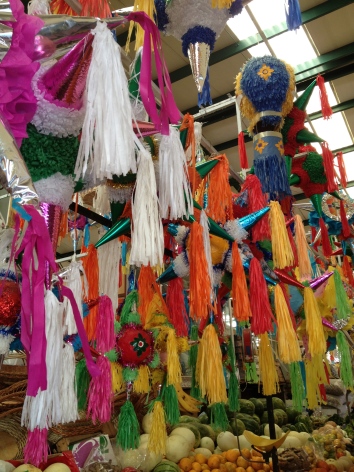
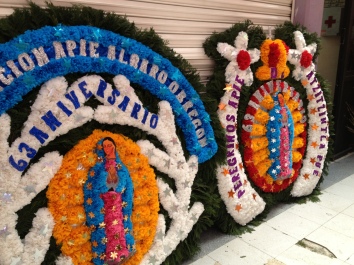
These decorations look like they are decorated with flowers but it’s paper!
Remembering the Dead Publicly during Dias de los Muertos
Posted: November 1, 2012 Filed under: Day of the Dead, Mexican Folk Art, Mexican Holidays, Mexican Style, Mexico | Tags: cockscomb, Day of the Dead, marigolds, Mexican folk art, Mexican holidays, mexican style Comments Off on Remembering the Dead Publicly during Dias de los Muertos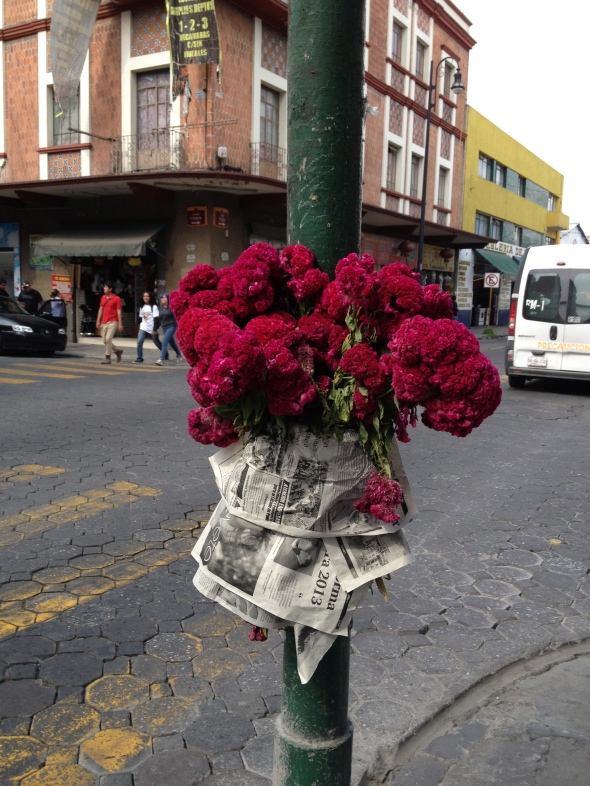
Public installations of folk art take many forms in Mexico. As I’ve said before, folk art is handmade, it is regional, it’s made of material available in one’s community, the methods are passed down from generation to generation and it expresses a community belief or value.
Here a simple bouquet of cockscomb attached to a traffic light in the middle of downtown Puebla not only provides passersby with a dab of beauty, but reminds everyone who passes, that a life was taken at this location. Someone died here. It raises our awareness that death is out there. In Mexico, death is not shoved into the back room. Death is a part of life and the Days of the Dead are a time to remember, both privately and publicly, those loved ones who have died.
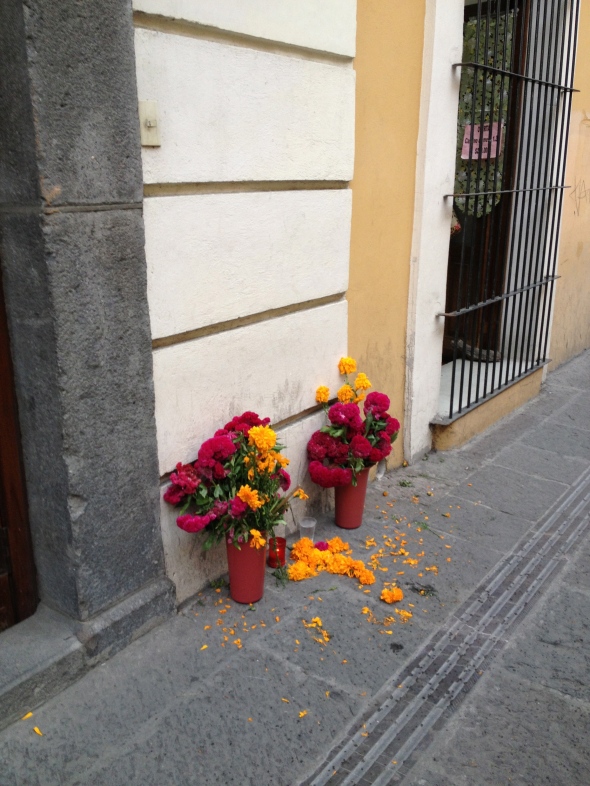
Someone else died here.
One sees bouquets and shrines built along the roads and highways of Mexico all year long. But during these special days of November 1 and 2, spontaneous eruptions of bouquets of marigolds and cockscomb appear in the cities and pueblos, reminding all of us that we are a mortal people and that life goes on after death.
New Carved Wood Hearts covered in Milagros
Posted: April 13, 2012 Filed under: Mexican Style, Mexico, Milagros, Religious Folk Art | Tags: Mexican folk art, Milagros, Religious folk art Comments Off on New Carved Wood Hearts covered in MilagrosHola! Just received a shipment of new hearts covered in milagros…some with beautiful golden wings, others are smaller or larger than we usually carry.
Check them out on our website, right here!
Hunting for Treasures in Mexico
Posted: March 30, 2012 Filed under: Folk Art, Mexican Pottery, Mexico, Zinnia Folk Arts Shop | Tags: Mexican ceramics, Mexican folk art, Tonala 2 Comments
As many of you know, there are lots of artesanias in Mexico. Artesania is not exactly the same as folk art or “arte popular,” although the two terms do get confused. I think of artesania as the little doo-dads (sometimes made in China) one finds in the souvenir shops (like the photo above) and arte popular comes artists or artisans and a long tradition of handmade regional arts. One of my jobs when I go shopping in Mexico is to hunt for the unusual, the well made, the quirky but cool objects that make up Zinnia’s little part of the Mexican folk art world.
The above photo is a shot taken at the Mercado in Tlaquepaque, Jalisco. I love to check out the markets in every town I visit for that little unexpected something that will delight our customers in Minneapolis and beyond. But looking at this photo you can see that it’s a little like finding a needle in a haystack!
I did find a few things here but then moved on to the real winners in another town, Tonala. Some of Mexico’s best ceramicists hail from Tonala. Here’s the front of the home of the Ortega family, one of the most well-known…

I visited 5 ceramic artists’ workshops yesterday in Tonala and spent a little time at the giant Mercado that happens every Thursday and Sunday. Again, there is a lot of junk but the occasional diamond. Patience and a keen eye are essential in this business!
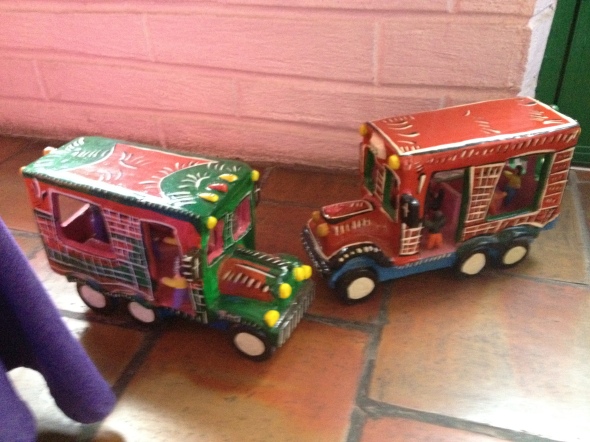
Mexico City Witches Market
Posted: February 3, 2012 Filed under: Mexico, Religious Folk Art | Tags: centro historico, curandero, Folk Art, Markets, mexican style, mexico city, Religious folk art 1 Comment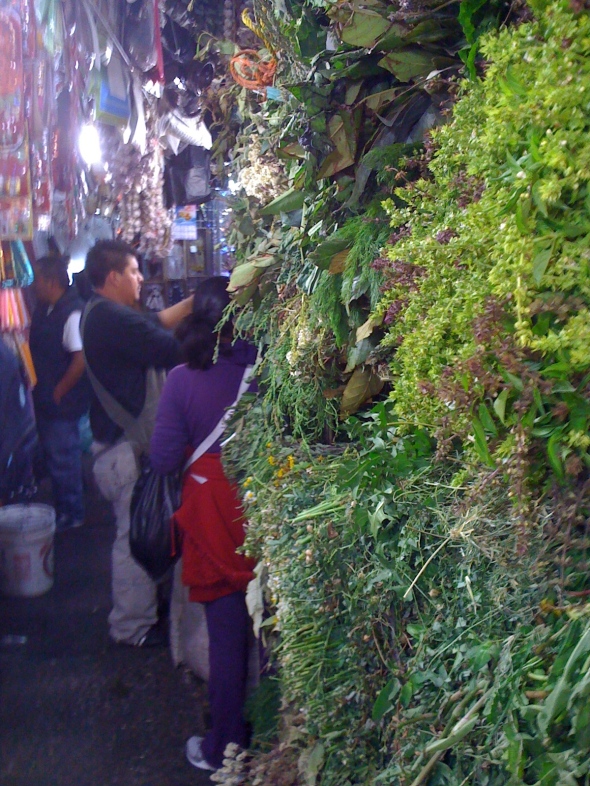
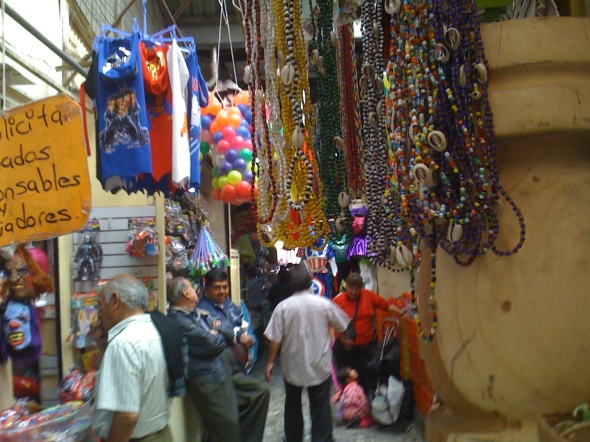

Sonora Market, also known as the “Witches Market,” is not far from the Centro Historico in Mexico City. It’s the place to go if you’re looking for ingredients to make a cure for an ailment, buy amulets to ward off or attract spirits, or to purchase a “limpia” or a “cleaning” from a curandero to get rid of the bad spirits. I went to see if there was anything interesting, and of course, like all markets in Mexico City, one can find just about ANYTHING!
Traveling to Mexico Today!
Posted: January 27, 2012 Filed under: Mexico | Tags: Mexico Travel Comments Off on Traveling to Mexico Today!I’m leaving on a jet plane this morning for a buying trip in Mexico. Minneapolis to Atlanta to Mexico City. Be sure to follow the blog or Facebook if you’d like to see some photos and a little description of what I’m up to. Last time I was trapped for a couple of hours in the Museo of Arte Popular in Mexico City because the streets flooded and the sewers backed up. More adventures are sure to happen!
UPDATE: Just arrived in Mexico City!


